
Bossiaea walkeri, commonly known as cactus bossiaea, cactus pea, or Walker's stick bush is a species of flowering plant in the pea family (Fabaceae) and is endemic to southern mainland Australia. It is a rigid, much-branched shrub with flattened, winged cladodes and red, pea-like flowers between July and November in the species' native range.
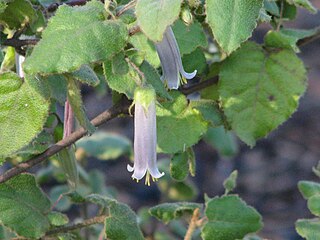
Correa aemula, commonly known as the hairy correa, is a species of shrub that is endemic to south-eastern Australia. It has broadly heart-shaped leaves arranged in opposite pairs, green or greyish green, pendent flowers arranged singly or in pairs and ageing to mauve-purple.

Bossiaea buxifolia, commonly known as matted bossiaea, is a species of flowering plant in the family Fabaceae and is endemic to south-eastern Australia. It is a prostrate to weakly erect shrub with elliptic to egg-shaped or almost round leaves and yellow, red and purplish flowers.

Bossiaea spinosa is a species of flowering plant in the family Fabaceae and is endemic to the south-west of Western Australia. It is a low, dense prostrate or rounded, twiggy shrub with egg-shaped to elliptic leaves and deep yellow to orange and pinkish-red, pea-like flowers.
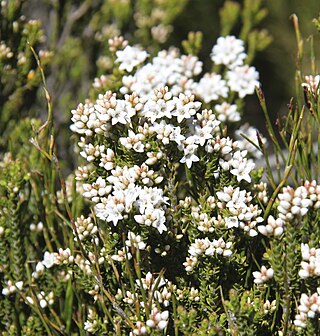
Epacris glacialis, commonly known as reddish bog-heath, is a species of flowering plant in the family Ericaceae and is endemic to south-eastern continental Australia. It is a prostrate to low-lying shrub with crowded, rhombus-shaped to broadly egg-shaped leaves with the narrower end towards the base, and tube-shaped, white flowers in small clusters near the ends of the branches.

Prostanthera phylicifolia, commonly known as spiked mint-bush, is a species of plant in the family Lamiaceae. It is an erect shrub with four-ridged branches, narrow egg-shaped to oval leaves and white or pale lilac-coloured flowers with purple and yellow spots.
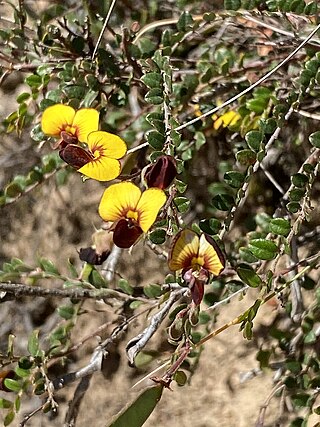
Bossiaea prostrata, commonly known as creeping bossiaea, is a prostrate understory shrub in the pea family, Fabaceae. It is a widespread species with orange-yellow flowers, purple-brown keels and trailing branches.

Prostanthera walteri, commonly known as blotchy mint-bush, is a species of flowering plant that is endemic to south-eastern Australia. It is a sprawling shrub with tangled, hairy branches, egg-shaped leaves and usually bluish green flowers with prominent purple veins arranged singly in leaf axils.

Prostanthera decussata, commonly known as dense mintbush, species of flowering plant that is endemic south-eastern Australia. It is a dense, compact, strongly aromatic shrub with egg-shaped leaves and mauve to violet flowers with yellow streaks, arranged in leaf axils near the ends of branchlets.

Prostanthera canaliculata is a species of flowering plant in the family Lamiaceae and is endemic to the south-west of Western Australia. It is a small, erect shrub with hairy branchlets, narrow egg-shaped to narrow elliptical leaves and pale blue or pale violet to white flowers with no markings.
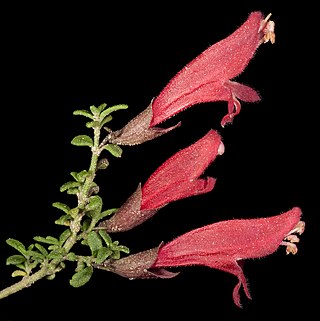
Prostanthera grylloana is a species of flowering plant in the family Lamiaceae and is endemic to Western Australia. It is a small, erect shrub with densely hairy branchlets, small, spatula-shaped leaves and red to pink flowers.
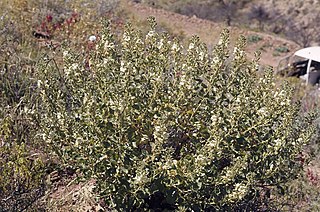
Goodenia chambersii is a species of flowering plant in the family Goodeniaceae and is endemic to South Australia. It is an ascending shrub with toothed, broadly egg-shaped to round leaves, racemes or thyrses of yellow flowers and oval fruit.

Bossiaea neoanglica is a species of flowering plant in the family Fabaceae and is endemic to eastern Australia. It is a prostrate to low-lying shrub with sparsely hairy foliage, egg-shaped to more or less round leaves, and yellow and red flowers.
Bossiaea obovata is a species of flowering plant in the family Fabaceae and is endemic to eastern Australia. It is a small, low-lying or prostrate shrub with egg-shaped leaves with the narrower end towards the base, and pea-shaped, yellow and red flowers.
Gompholobium polyzygum is a species of flowering plant in the family Fabaceae and is endemic to north-western Australia. It is an erect or prostrate shrub with pinnate leaves each with sixteen to twenty-one pairs of leaflets, and yellow-orange and greenish, pea-like flowers.

Bossiaea scortechinii is a species of flowering plant in the family Fabaceae and is endemic to eastern Australia. It is a prostrate to low-lying shrub with simple, elliptic to egg-shaped leaves with the narrower end towards the base, and orange-yellow flowers with red to pinkish markings.
Pomaderris forrestiana is a species of flowering plant in the family Rhamnaceae and is endemic to south-western Australia. It is a low shrub with elliptic leaves, and small clusters of woolly-hairy flowers.
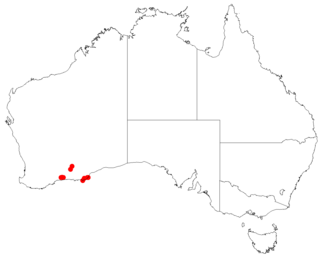
Leucopogon bossiaea is a species of flowering plant in the heath family Ericaceae and is endemic to a restricted area in the south-west of Western Australia. It is an erect shrub with elliptic to broadly egg-shaped leaves and white flowers in four to eleven upper leaf axils.
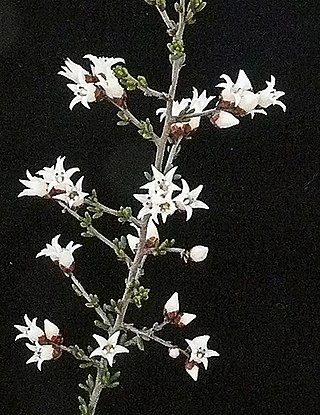
Cryptandra magniflora is a species of flowering plant in the family Rhamnaceae and is endemic to Victoria (Australia). It is a shrub with cylindrical leaves, and clusters of white, tube-shaped flowers.

Androcalva melanopetala is a species of flowering plant in the family Malvaceae and is endemic to southern inland Western Australia. It is a sometimes prostrate shrub that has densely hairy new growth, egg-shaped to elliptic leaves with rounded teeth on the edges, and clusters of white or cream-coloured and pink to red flowers.


















